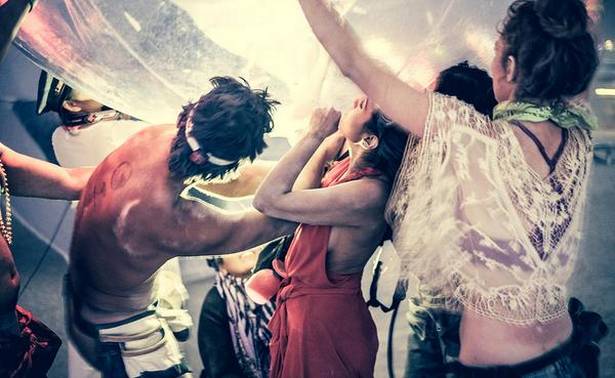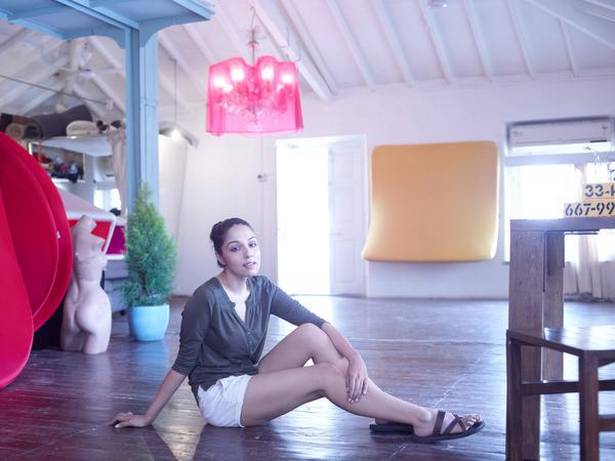Lekha Washington is multi-tasking — with a new Social project, installations, and a lunar-inspired artwork that she is planning to cycle with at the Burning Man festival in August
Behind the wooden doors of an ancestral property in Bandra’s quaint Ranwar village, Lekha Washington’s design space, The Upstairs Studio, is buzzing with activity. As I head to the upper storey, I find the actor-designer-entrepreneur in the middle of several works in progress. Keeping her cool in a casual-chic grey robe and strappy silver Steve Maddens, she explains that she and her team, grouped across the room, are grappling with several projects — from an upcoming test run at Bandstand, of the installation she is showcasing at this year’s Burning Man festival, to four new designs (including a moon light) for her company, Ajji. Meanwhile, Shanto, the pet cat, snoozes, curled up in one of her signature Squair chairs.
Chatting about the neighbourhood, now home for the past five years, gives me a fair idea of her easy familiarity with the people and the culture of the place. And also the fact that while Washington may not be acting at the moment, the frenetic pace of her life has not calmed in any way. “I am a dissatisfied soul. I’ll finish a great project and then feel the need to do something big in a totally different field. I need to be constantly evolving,” she says. Just this year, she teamed up with luxury vodka brand Belvedere for their artistic endeavour, Studio B — creating A drop of the universe, an artwork speckled with tiny white dots, that is at once like a disco ball apt for a launch party and an enigmatic spatial body reflective of her current style of work. She is also working on a breath installation she hopes to showcase at the Kochi Biennale (“I have not had the bandwidth to contact them yet”), and her first interior design project, Riyaaz Amlani’s soon-to-open Social in Bengaluru.
Riding in the desert
The Chennai girl, who now calls Ranwar’s hipster neighbourhood home, is no stranger to community living and alternate cultures. Washington is the only Indian artist to be given the honoraria grant for Burning Man (won after an elaborate two-step, year-long selection process) this year. Held annually in Nevada, in the middle of the Black Rock Desert, Burners (as the 70,000 attendees are known) create what the fête’s website describes as a “temporary metropolis dedicated to art and community”.
__________________
- The moon — larger than life but universally relatable — is a recurring motif in Washington’s art. Explaining her interest, she says, “It doesn’t belong to anybody, yet belongs to all of us, and it symbolises a lot: notions of the continual cycles of things, inherent change, lunacy, etc.” Interestingly, in keeping with the concept of change, her work, This too shall pass, has also gone trough multiple iterations since she first created it (and exhibited it at a collateral at the 2014 Kochi Biennale), the final version of which will light up the sky at Burning Man between August 26 – September 3. A self-confessed geek, technology also informs much of her work. “There is so much to explore. I feel technology is the next level when it comes to art — to make it intuitive, real, and not a gimmick, that is fascinating for me.”
___________________
The designer, who is returning for a third time, describes how it is a unique art festival in terms of its non-commercial culture. In what looks like a set straight out of the post-apocalyptic world of Mad Max: Fury Road, the vibe is quite the opposite — one of freedom of expression, free love and creativity. The week-long fair sees people from the world over, living as a community, being part of this alternate shared experience. And all this while braving the extreme weather and figuring out their own means for survival. “It’s a sort of gifting culture, outside of the capitalist system we’ve all been indoctrinated with. It’s why I like it so much; it’s incredibly refreshing to engage with a new system,” she shares.
The focus, she says, is on interactive public art that holds immediacy — reflective of life’s ephemerality — in high regard. Works, often as large as 40 feet high, are set up on location, with the help of teammates and Burners. Incidentally, it was a photograph from Black Rock City — “of an installation of a series of balloons, one tied to the other, very basic in its concept” — that inspired Washington’s moon artwork. “So, for me, it’s coming full circle to show them here,” she says. Her excitement though, is tinged with anxiety. Her helium work from last year did not fare too well in the harsh climate, where the intense dust storms ended up “sandpapering” the work.
This year, she is introducing a newer iteration, This too shall pass – Moondancer— a ginormous 12-foot helium globe modelled on the moon, designed to rotate on its axis, reflecting the changing phases of the lunar cycle. While last year saw her clambering up a stationary plane to hoist her five balloons, this year the single globe will be pivoted on a tricycle that she and two others will ride around the grounds each night, while the shape-shifting ball waxes and wanes against the desert sky.
A fine balance
Washington’s work, though large scale, has a simple idea at its core. “We’ve been trying to create work that positively affects people’s lives in terms of art,” she tells me, leading the way across the wooden floorboards to a smaller room. With Theheraav, a work in progress, one needs to lie down under a sonar sensor placed within a spangle of lights, which picks up one’s micro-movements. The light bulbs grow brighter or dimmer in reaction to levels of stress or calm and, in the process, one is forced to focus on one’s breathing
Currently the centrepiece at the studio is the 18-foot Whirling Dervish, a touch sensitive art piece being readied for Amlani’s co-working space. Both the artwork and the space are designed by Washington, who strays from the norm with a clean, whitewashed look instead of the usual brick-exposed grunge feel of most Socials. It will also include several other artworks, from textile and paintings to 3D, neo-pixel and sound interactive work — the idea being that the space resembles an artist’s incomplete studio, one that is messy and alive, quite like her own. “It is set to open next week. There will be art supplies, each table will have calligraphy pens, and we will have a library of art books and local zines,” adds the designer, who is inspired by artist Salvador Dali and architect Zaha Hadid.
This would not be the first time that Washington’s personal and professional worlds collide. She believes her work, be it art or acting, revolves “around ideas and creativity”, and hence is actually all the same thing. “My work is a sort of reflection of myself”, even when the “nature of the medium” is slightly different.
Lights, camera, action
For someone who walked away from an acting career in an industry that reeks of “patriarchy and nepotism”, she has seen herself grow alongside her company. “The change for me has been much more personal. I’m very comfortable in my own skin and I now have the financial wherewithal to have a freedom of choice: I’m creating exactly what I want to create.” Her studio, she thinks, is an extension of her need to nurture creative expression of all kinds. So it hosts poetry readings, film screenings and experimental plays. “Educationally, creativity is not very nurtured. Academics is, industry is, but thinking out of the box is not. This is what I’m trying to do with this space.” Of course, the access to her space is conditional and open to only “those I like”, she mentions as an afterthought.
Washington is also making a return to cinema, and she hopes the industry post her sabbatical of half a decade is “less insular”, thanks to corporatisation and the influx of online platforms like Netflix or Amazon. This time, in addition to acting (and penning lyrics for Vishal Bhradwaj for Rangoon), she is collaborating on a script.
Taking a stand
Straddling multiple careers has proven to be quite an uphill task, though. She often finds herself in conflict with things beyond her control. From non-existent patenting laws to a basic lack of confidence in one’s talent, she feels India is living in a “design shadow”. As proof, she narrates an incident where her chair, The Pink Sink, was replicated by a German artist just six months after she showed it at the 2014 International Contemporary Furniture Fair in New York. The artist in question ended up winning a Red Dot award! Earlier this year, she also spotted an iteration of The Dot chair at the Salone del Mobile Milano. “The Indian design community needs to come together and make an impact. In isolation, individual designers can’t fight it,” she says.
______________________________
- Dust goggles: Because it is “extremely hot and dusty”
- Spirit of adventure: “You must be willing to say yes to anything that comes your way”
- Minimal yet outlandish clothing:“It’s all about radical self expression. I get to be as ridiculous as possible and there’s no one to judge me,” says Washington, who will also be carrying a red gown to wear while riding the tricycle.
- Food and water: She will be putting together enough for a team of 20-odd people, friends from various parts of the world, who will be joining her as co-campers. “I will also be carrying tiny bottles of Old Monk rum to gift people, because it is a gifting culture.”
_____________________________________
Her plate full, she is not exactly complaining. But she is always open to collaborations — earlier ones include works with couture embroiderer Jean-François Lesage and designer Pinakin Patel. “I like the variety, hence the performance, the writing, the art. I just need to find people who are also pushing boundaries,” says Washington, who takes this joie de vivre into her travels, too — deep sea diving, sky diving and “engaging with life” everywhere. And along the way, if she claims to look a tad frazzled, one can nod in (false) agreement. Meanwhile, Shanto, now awake, disappears beneath the dervish, even as her team bustles around.
— With inputs from Surya Praphulla Kumar
source: http://www.thehindu.com / The Hindu / Home> Life & Style / by Tejal Pandey with input from Surya Praphulla Kumar / June 08th, 2018



